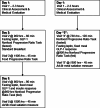Test of a biobehavioral model linking weight suppression to binge-eating severity via leptin and glucagon-like peptide 1 in bulimia nervosa and related syndromes in women
- PMID: 40576074
- PMCID: PMC12234017
- DOI: 10.1017/S0033291725100871
Test of a biobehavioral model linking weight suppression to binge-eating severity via leptin and glucagon-like peptide 1 in bulimia nervosa and related syndromes in women
Abstract
Background: Weight suppression represents the difference between highest and current body weight and predicts maintenance of bulimia nervosa and related syndromes (BN-S). This study tested a biobehavioral model of binge-eating severity in which greater weight suppression links to reduced leptin, which links to reduced glucagon-like peptide 1 (GLP-1) release, which links to both decreased reward satiation and increased reward valuation, which link, respectively, to excessive food intake and loss of control while eating - the defining features of DSM-5 binge-eating episodes.
Methods: Women (N = 399) who met DSM-5 criteria for bulimia nervosa or another eating disorder with binge eating (n = 321) or had no lifetime eating disorder symptoms (n = 78) participated in a multi-visit protocol, including structured clinical interviews, height, weight, weight history, percent body fat, fasting leptin, post-prandial GLP-1 response to a fixed meal, and self-report and behavioral assessments of food reward satiation (ad lib meal) and food and nonfood reward valuation (progressive ratio tasks).
Results: A structural equation model (SEM) demonstrated excellent fit to data with significant pathways from greater weight suppression to lower leptin, to blunted GLP-1 response, to lower reward satiation, to larger eating/binge-eating episode size, with significant indirect paths through leptin, GLP-1, and reward satiation. SEM with paths via reward valuation to loss of control eating demonstrated inadequate fit.
Conclusions: Findings specifically link reduced GLP-1 response to severity of binge-episode size and support weight history assessment in eating disorders, DSM-5 over ICD-11 criteria for binge eating, and may inform future clinical trials of GLP-1 agonists for BN-S.
Keywords: GLP-1; binge eating; bulimia nervosa; eating disorders; glucagon-like peptide 1; leptin; reward; satiation; weight suppression.
Conflict of interest statement
Dr. Keel receives royalties from Oxford University Press outside the submitted work. Dr. Appelbaum serves on the Advisory Board of EMD Serono for HIV research outside the submitted work. Dr. Bodell and Dr. Williams declare none.
Figures



Similar articles
-
Examining Weight Suppression, Leptin Levels, Glucagon-Like Peptide 1 Response, and Reward-Related Constructs in Severity and Maintenance of Bulimic Syndromes: Protocol and Sample Characteristics for a Cross-Sectional and Longitudinal Study.JMIR Res Protoc. 2025 Apr 8;14:e66554. doi: 10.2196/66554. JMIR Res Protoc. 2025. PMID: 40198107 Free PMC article.
-
Psychotherapy for bulimia nervosa and binging.Cochrane Database Syst Rev. 2003;(1):CD000562. doi: 10.1002/14651858.CD000562. Cochrane Database Syst Rev. 2003. Update in: Cochrane Database Syst Rev. 2004;(3):CD000562. doi: 10.1002/14651858.CD000562.pub2. PMID: 12535397 Updated.
-
Psychotherapy for bulimia nervosa and binging.Cochrane Database Syst Rev. 2001;(3):CD000562. doi: 10.1002/14651858.CD000562. Cochrane Database Syst Rev. 2001. Update in: Cochrane Database Syst Rev. 2003;(1):CD000562. doi: 10.1002/14651858.CD000562. PMID: 11686968 Updated.
-
Weight Suppression, Binge Eating, and Purging as Predictors of Weight Gain During Inpatient Treatment in Persons With Bulimia Nervosa.Eur Eat Disord Rev. 2025 Sep;33(5):941-949. doi: 10.1002/erv.3197. Epub 2025 Apr 7. Eur Eat Disord Rev. 2025. PMID: 40195010 Free PMC article.
-
Psychotherapy for bulimia nervosa and binging.Cochrane Database Syst Rev. 2000;(4):CD000562. doi: 10.1002/14651858.CD000562. Cochrane Database Syst Rev. 2000. Update in: Cochrane Database Syst Rev. 2001;(3):CD000562. doi: 10.1002/14651858.CD000562. PMID: 11034689 Updated.
References
-
- Anini, Y., & Brubaker, P. L. (2003). Role of leptin in the regulation of glucagon-like peptide-1 secretion. Diabetes, 52(2), 252–259. http://www.ncbi.nlm.nih.gov/entrez/query.fcgi?cmd=Retrieve&db=PubMed&dop... - PubMed
MeSH terms
Substances
Grants and funding
LinkOut - more resources
Full Text Sources
Miscellaneous

